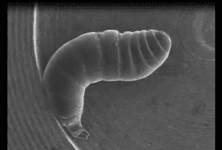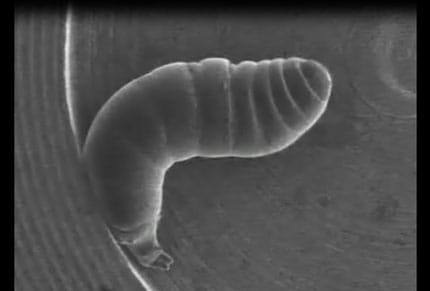Nanosuit to Keep Insects Alive in Vacuum

Scanning Electron Microscopy is one of the most important analytical methods widely for studying the surface topography and composition of a variety of samples including metals, geological and biological specimens. The highly magnified hi-res images obtained from SEMs are useful for detailed study of morphology and specimens which may include insects, tissue and cell samples etc.
The samples used in SEM should generally be devoid of moisture or any volatile components and have to be electrically conductive. The vacuum system in the specimen chamber sucks out any moisture present in the specimen. When an insect is subjected to vacuum in the specimen chamber of SEM, only a desiccated lifeless husk is left behind which makes it virtually impossible to obtain high resolution close up images of live specimens at nanometer level.
A team of researchers from Japan’s Hamamatsu University School of Medicine led by Takahiko Hariyama have accidentally stumbled upon a solution for this issue when the fruit fly larvae placed in the specimen chamber carried on wriggling as if nothing has happened and then later matured with no adverse effects. On further investigation of this phenomenon revealed that the electron radiation from SEM combined with the natural film covering the larval surface to form a protective layer over the larvae by linking the molecules to one another and retaining the moisture within the polymerized nanosuit.
All insects don’t have a film covering them which forms a nanosuit when exposed to an electron stream, hence they created artificial nanosuits by coating the mosquito larvae in Tween 20 solution and then exposing these larvae to plasma to polymerize Tween 20 and form a nanosuit around them. These nanosuited larvae exposed to vacuum in the SEM specimen chamber could sustain for about 30 minutes before getting completely dehydrated and dying as compared to the ones without the nanosuits which dehydrated and died within few minutes.
The same experiment conducted on other insects including flatworms, ants and sandworms exhibited similar results. These nanosuits will now make it possible to record high resolution live nanoscale videos of even the tiniest insect organs while in motion and open new avenues for imaging and studying live specimens. This study has got the scientists at NASA and other organizations interested in finding the possibility of creating nanosuits for humans which can withstand harsh environments in the outer space and also the possibility of nanosuited life forms surviving the travel through space on meteorites or comets.
The first video <here> shows the effect of vacuum in SEM specimen chamber on mosquito larvae without the Tween 20 nanosuit, where as the second video <here> shows how nanosuited mosquito larvae can survive in the similar conditions.
Image: A nanosuit created by scientists Takahiko Hariyama at the Hamamatsu University School of Medicine in Japan, which allows insects to survive in a vacuum. (Photo : Yasuharu Takaku et al, Hamamatsu University School of Medicine)
Source: ScienceNOW


